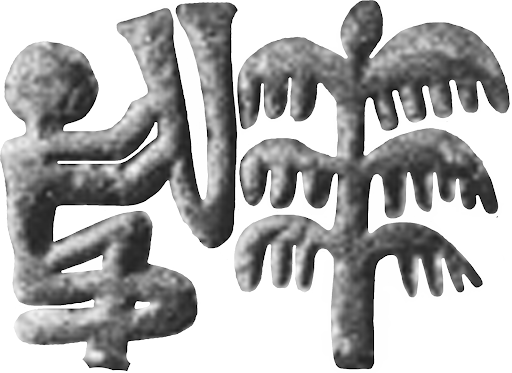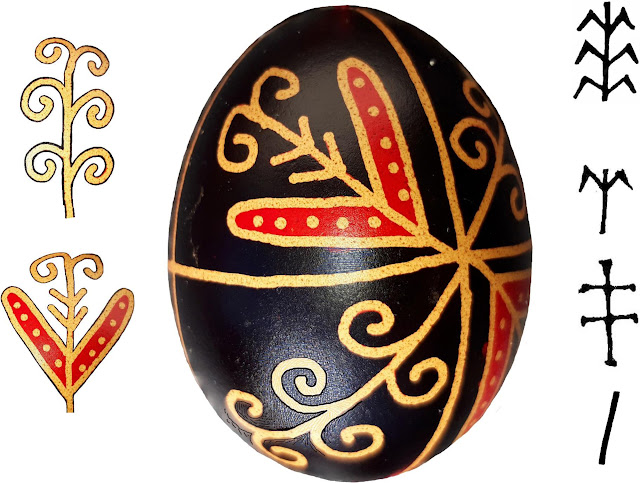A world tree shown on a pottery given by Asko Parpola can be read as szabir ancestor
Szabír ős olvasatú világfa egy Asko Parpola által közzétett indusvölgyi cseréptáblán
Readable World tree conference, Jànos B. Nagy and Géza Varga
Asko Parpola reports in Study of the Indus Script a text on the pottery of the Indus culture (1) and gives explanation for that (Figure 10). The world tree picture on the pottery can be identified with the Secler writing "tprus"(ancestor tapar, sabir ancestor), i.e. it can be deciphered (Figure 1). In this paper we shall show the parallelism of the Indus hieroglyph, representing this way the connection of the early writings and the origin of the writing (2).
Following Asko Parpola the three signs show a ceremony presented to the world tree. With the help of the Secler writing and the Hungarian hieroglyph writing we can confirm this, and we can complete even more this picture. Following this the tree presumably represents the tapar/sabir people name and phonetic pronunciation, and the readable üst is probably prepared from matal (bronz or copper).
Figure 1. On a pottery from Indus published by Asko Parpola somebody is presenting an offering to world tree read as "szabir ancestor", with "u" (ushu "copper", or üst "caldron") vessel
On the first figure we can see the part representing the offering. The figure satisfies the content with the three signs, showing that these are hieroglyphs (word- and sentence-signs linked to ancient religion).
- The squatting antropomorph figure is the sign of "man" in Sumerian writing, also probably here it means the same.
- The vessel in the hands of the man reveals the letter "u" and "v" in the Secler letters (that are intermediate between the Phoenician - Latin "u" and "v"). The reconstruction of the acrophony of the Secler signs leads to Hurrita (Sabir) "ushu" copper, the Armanian "waske" iron and the Hungarian "vas" (earlier "vaske") (Figure 1/d and 1/e). These words are reminiscent of the original word őskő "ancient stone", that could be the name of the meteorite iron given by "ancient Heaven Farther". At dawn of the metal ages they perhaps only meant "meta", that became later "copper" or "iron". With further simplifying the Latin "u" and "v" letters were created from these word signs. This demonstrates that the Indus writing, the Secler writing and the Latin writing stemmed at least on the Szabir territories (in Middle East) from the international stock of signs at dawn of the metal ages. Thanks to this, the Secler writing could help those researchers, who are busy in deciphering the Indus writing.
- The third sign is the most interesting one representing the world tree well put in evidence. It can be identified with the sign "tprus" conserved in the alphabet of Nikolsburg (tapar us "szabir ancestor") (Figure 2). An exact corespondence can be found on an ancient Sabir pottery (Figure 3), on a writing found in Göbeli tepe (Figure 4), on a Longobard disc (Figure 5), on a pottery from Sztalacs (Figure 6) and on an american stone drawing (Figure 8).
The sign testifies that the Indus people, also we Hungarians could bring the tree representation from the region of Subartu. The Sarmats could play a role in transmitting it directly to Europe (Figure 7).
Following Asko Parpola "The outward shape of the U- and V-shaped Indus sign suggests 'pot' as its "pictorial meaning". A contextual clue suggests that the "intended meaning" is also 'vessel', or more exactly 'sacrificial or offering vessel'. Homophony in the form of puns undoutedly played a role in folklore long before it was utilized in writing. Importantly, puns usually are language-specific: we have a chance to identify the language that underlies the Indus script and to recognize the phonetic value of the sign(s) involved only in those cases, where the rebus principle has been applied".*
* Cf. M-478A and M-479A in Joshi & Parpola 1987:115
Following Konstantinos Porphyrogennetos the old name of Hungarians is Sabir (following he szavartü aszfalü). The tree reaching the sky (world tree) has the branches curved down, because of the weight of the sky, that was also reported by Jànos Berze Nagy followig the Sibarian myths. Based on the branches curved down it is obvious that we can see the tree reaching the sky on the Indus table. What is also reinforces that there is an offering to the tree, because the ancestors have identified the world tree (the Milky Way) with God.
Figure 2. The sentence sign "tprus" of the alphabet of Nikolsburg of the Sekler writing (tapar ős "sabir ancestor")
Figure 3. The sentence sign tapar ös "szabir ancestor" on the ancient territory of Subartu, or on a vessel dated close in time and geographically close to it (Hissar, BC 4300)
Figure 4. Reading of a 12000 years old document of Göbeli tepe: Lyuko ten "Lyuko Sun God", on the right the corresponding Sekler signs: the "ly"(lyuk/Lyuko) and the "tprus"(sabir ancestor)
Figure 5. The sentence signsof an Italian Longobard disc written with Hungarian hieroglyphs: Lyuko the ancestor of Sabir (left) and the crresponding Sekler "ly"(lyuk/Lyuko), "tprus"(tapar ős "sabir ancestor) and "ős"(ancestor) signs (right)
Figre 6. The sentence sign "Sabir ancestor" on a vessel from Sztalacs in the XV. century following Vesna Bikic
Figure 7. A Sarmat vessel with "tprus"(tapar ős "sabir ancestor") sign
Figure 8. A stone sign from the region of Grand Gulch of Anasaz (above left), the sign "tprus" of the Sekler alphabet of Nikolsburg (above right) and a photo of an indian stone drawing (below)
Figure 9. The Sekler rune "u"(represented by a semi-finished casting in an animal skin), from this came out the Latin writing "u" and "v"
Figure 10. The Sekler rune "v" came out of the above sign
Figure 11. The runic letter "v" of the Sekler script was extracted from the above sign
Figure 12. On the idol of Bojna from the VII-IX. century the "Very great Sir, the ancestor of Sabir lives"
Figure 13. The reading of the painted egg from Dobronak: "The brilliant Unique God, the ancestor of the Sabirs"
Notes
(1) Following the author the Indus civilization was the result of a long cultural process. The first neolithic villages stem from 7000 BC. In the period beginning from ca 4300 Kalkolit age, the villages bicame bigger, copper ustensils and circular marvellously painted ceramics appeared. The seals testify of the development of administration and writing beginning around 3200 BC in the early Harappa age, and the watering canals appeared. They made a living commercial contact with the territories of Iran and Middle Asia. The ripe Harappa culture (2700 - 2500 BC) was able to construct cities as Mohenjo - daro. This city - in opposition to the Mesopotamian and Egyptian sites - was without palace and church. The Indus civilization has ended around 1900 BC and the Indus writing disappears. The inhabitants remain however, but the inhabitants of the BMAC culture are penetrating to its territory.
(2) Following the author S.R. Rao archaeologist in his "The deciphering of the Indus script" (1982) affirms that the Indus writing is the basis not only of the Brahm writing, but also of the Semitic consonant alphabet, that is considered by most of the scientists stemming from the Egyptian hieroglyphs.
We can add, that the reason of these contradictions is the great number of similar signs in the writing systems. This - exagerating somewhat - gives the possibility of originating any language from any other language and also the opposite. Writing systems generated by polygenesis are imagined and they are inventig originating hierarchies between them. The academic science did not form a complete picture, for example it cannot keep the sign systems of the stone age (Figure 4) and neither the popular sign customs (Figure 12).
Oppositely, the probability calculation carried out with the help of the mathematician Tibor Nemetz in 1993 showed that the world writing- and sign-systems are related with an old parent-form. The fortuitous coincidence of the signs is completely excluded, the similar signs demonstrate that the writing was born by monogenesis. Originally, the use of the signs was born on a religious mean of the sign systems of the old stone-age religion. The hieroglyph sign system is still alive up to now (for example in the Sekler writing) and is present with 20 - 50 commun signs in the various world writing systems. These commun signs are found by the researchers in various cultures and form on this basis their point of view on the neighbouring writing systems.
The sentence sign representing szabir ős "sabir ancestor" is world widespread and shows that a unified sign system of the old religion arrived at remote world territories.
LitteratureAsko Parpola (2005): Study of the Indus Script
Vesna Bikic: Sgraffito kerámiadíszítés és csoportidentitások a középkori Balkánon (academia.edu)
Varga Géza (2017): Magyar hieroglif írás, írástörténeti Kutatóintézet, Budapest
Varga Géza: Szarmata tartalom
Az egyik legszebb és legjobban felszerelt őrségi szállás, a veleméri Cserépmadár szállás és Csinyálóház portáján tekinthető meg a











Nincsenek megjegyzések:
Megjegyzés küldése